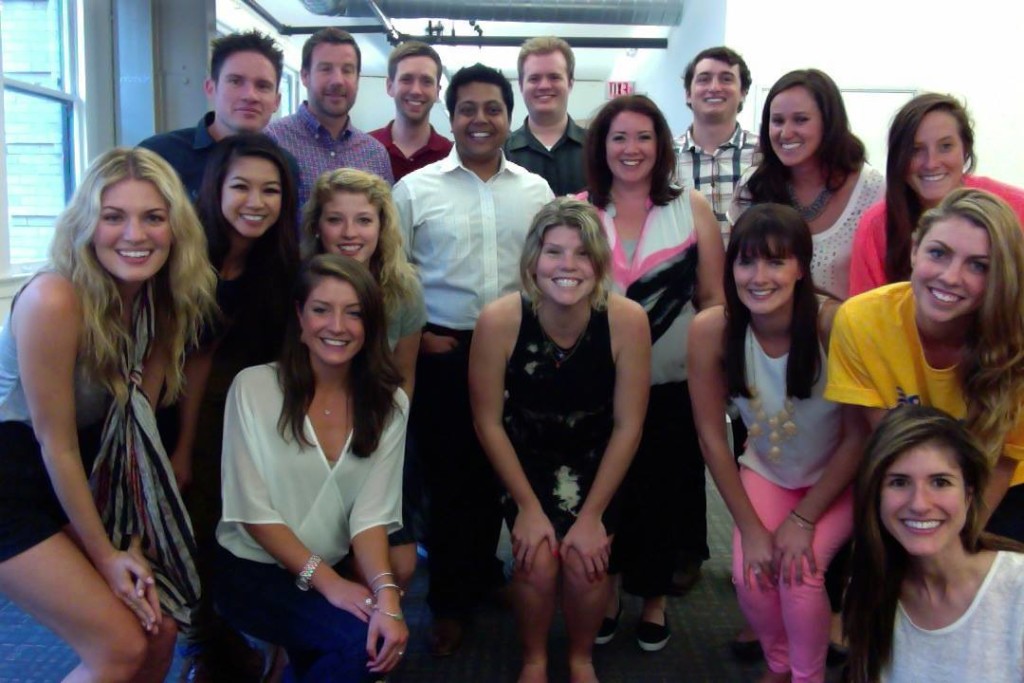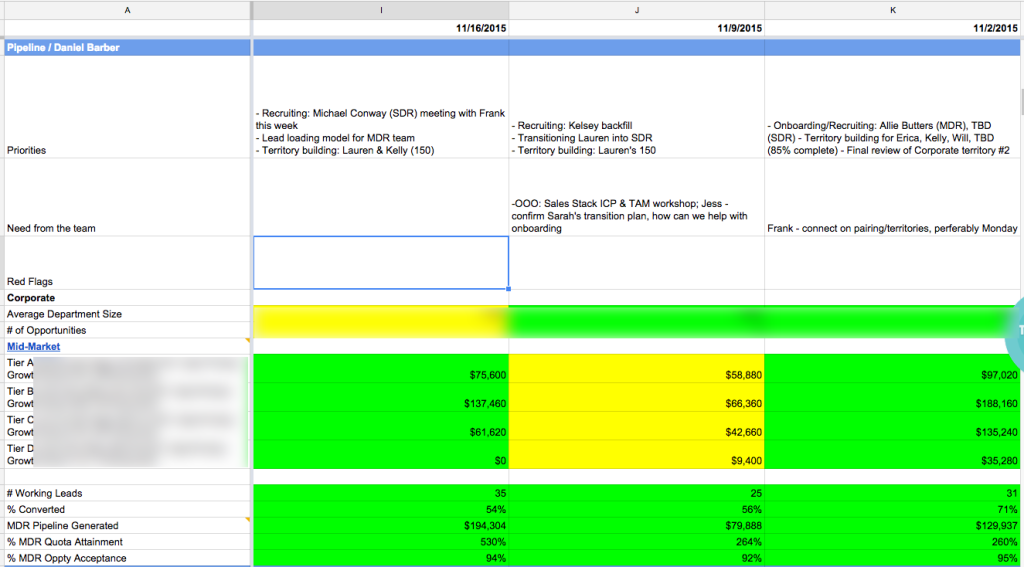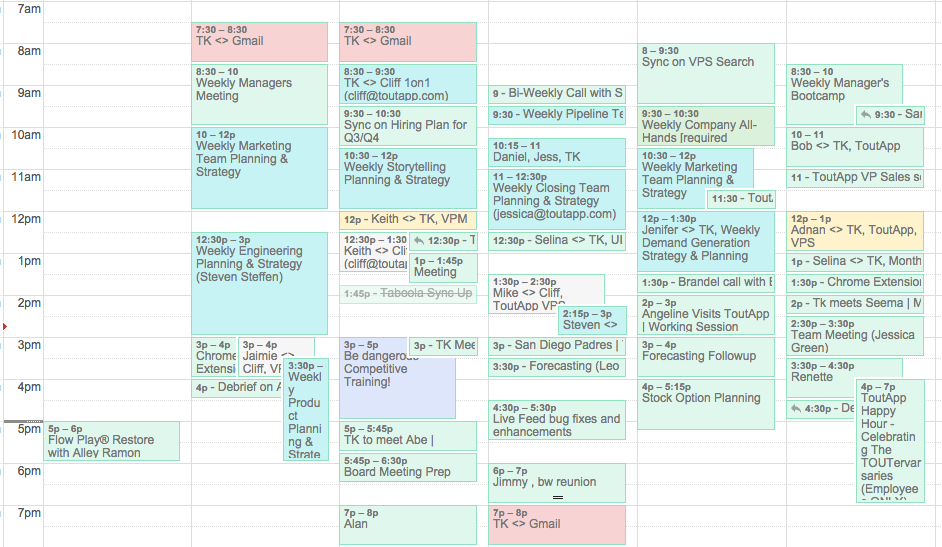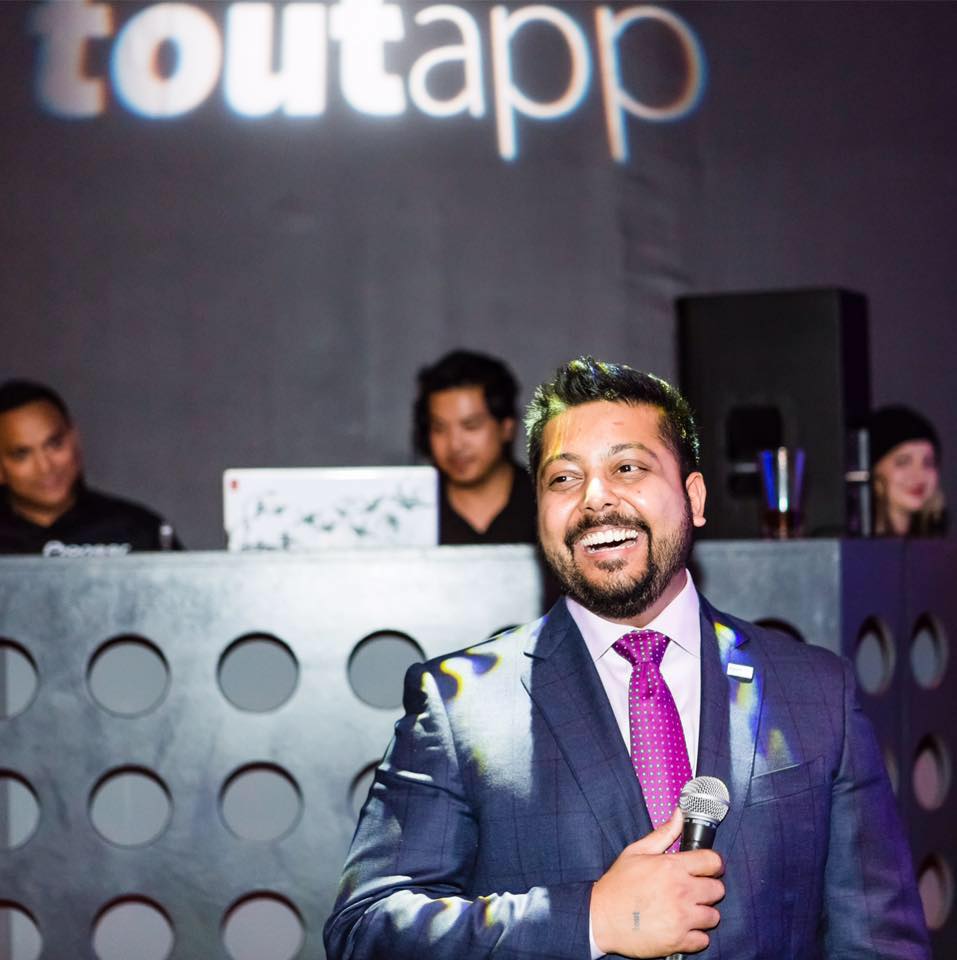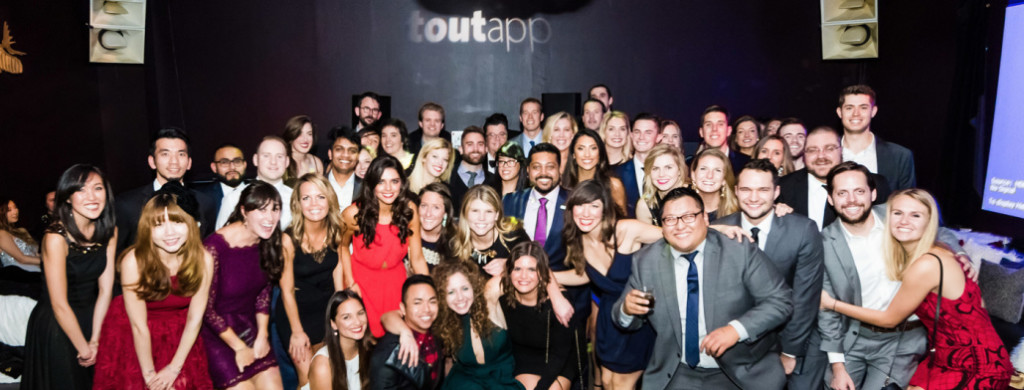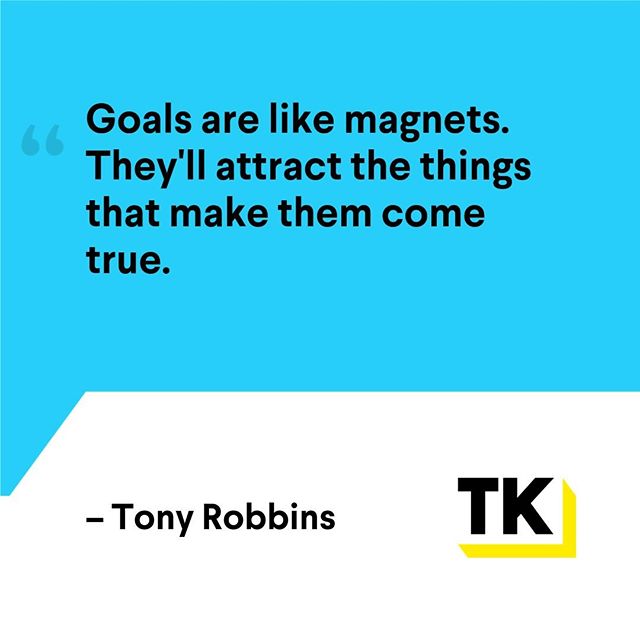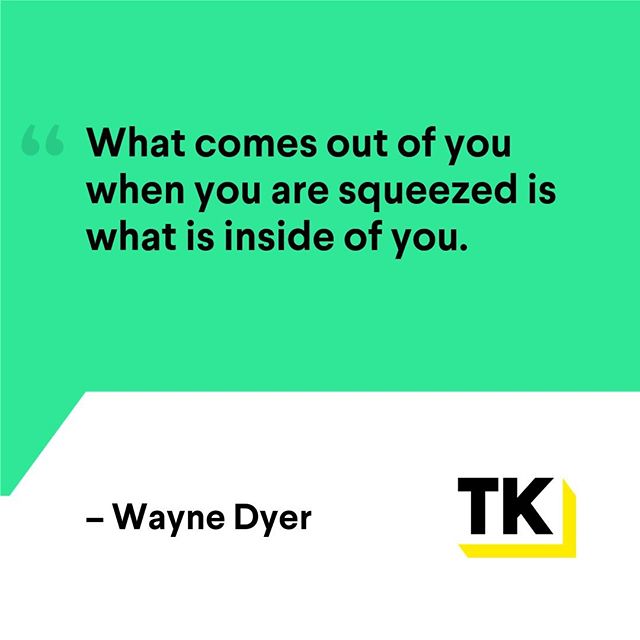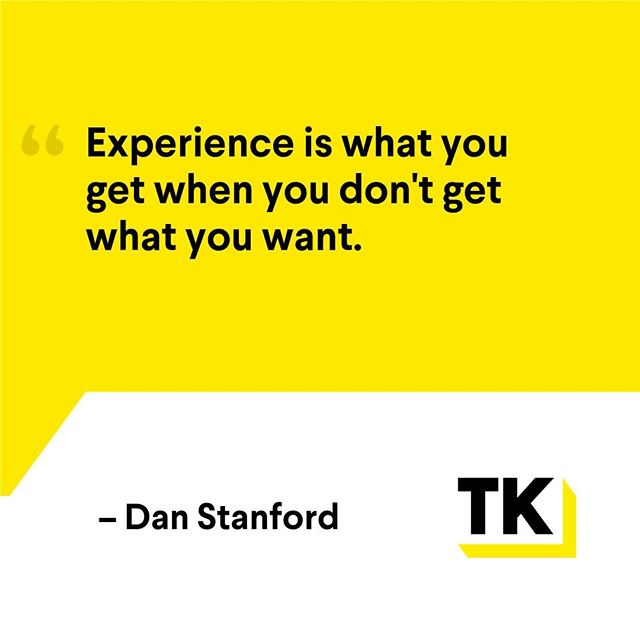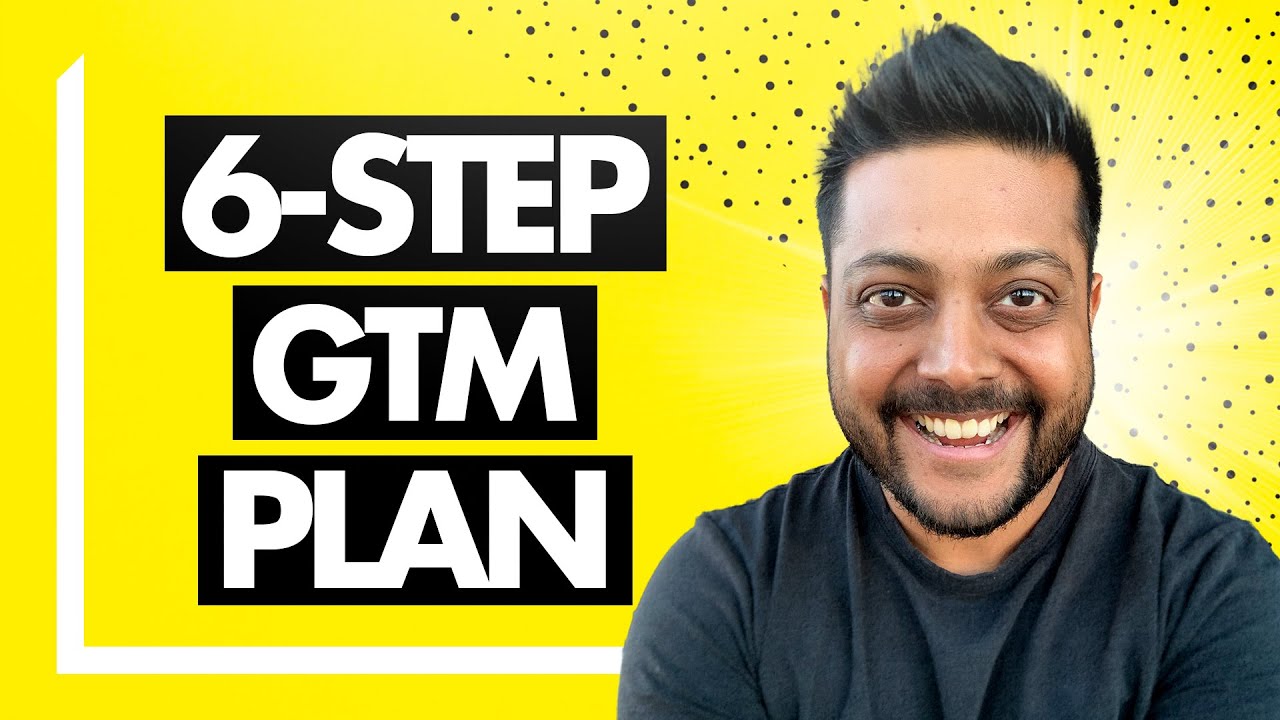In this blog post, I’ll be reflecting on my journey as the Founder & CEO running company ToutApp over the past two years (2014 and 2015).
ToutApp was founded in 2011.
Over the last two years, we grew ToutApp’s revenues through triple digit growth, grew from being a 7 person company to now going 65-people strong, and also raised nearly $20m+ of venture capital led by Andreessen Horowitz (Series B) and Jackson Square Ventures (Series A).
We did all this by bringing on 1,000+ customers whose sales teams now run on ToutApp across their SDR, AE and CSM teams.
For those of you that haven’t been following my story, in 2010, I quit my 6-figure hedge-fund job to start my own company.
In 2011, we incorporated ToutApp and joined the 500Startups Accelerator Program and raised our advisory round from awesome angel investors including Esther Dyson, Eric Ries and others.
In 2012, I went beyond being a just a solo-founder and a one man show and started to build out a whole team. Through 2013, we figured out our category, our focus and reached true product market fit.
You can read a summary of my past blog reflections here.
While there is so much to talk about in a post like this, I’ll be focusing on some key lessons learned as I continued my journey from being a founder with a dream to being a CEO of a fast growing startup poised to be a leader in a brand new category of Sales Software.
This is a long form post. First, I’ll provide a quick overview of what happened in 2014 and 2015 for context. Secondly, I’ll share 4 key lessons learned as the CEO of ToutApp.
- Lesson #1 -Â After fundraising, effective recruiting is the lifeblood of your organization
- Lesson #2 – You have to be ruthless about how you run your operations
- Lesson #3 – You’ll have a completely different business every quarter; adapt
- Lesson #4 -Â Compartmentalization helps you get through all the things that goes wrong
2014
In my 2013 recap, I found that it takes 3-years to figure out if what you’re working on might work. Some call this product market fit. Others call it traction.
That 3-year calculation includes the period of bumbling around that leads to traction.
While I think that it is possible to disrupt an existing market in a much faster clip, if you find yourself creating a new category, the 3-year rule almost certain holds true.
At the end of 2013, which was roughly our 3-year mark, ToutApp was still a small startup that had only raised $1m in seed. With a 7-person team, we got to the magic $1m in ARR.
We entered 2014 hot off a Series A fundraise of $3.35m led by Jackson Square Ventures. We entered 2014 with the intention to mature and scale as a company.
Being the leader of a seed stage startup with no board to having a formal board and having millions in the bank meant we had to grow up as a company and more importantly, I had to grow up as a CEO.
Up until 2014, we were a very product focused company. We had a self-serve B2C style business where salespeople would discover us on their own and sign up for our product with their own credit card.
We had just started to get a taste of what closing 1-year deals through sales would do for our business.
The biggest change we made in 2014 was our switch from a B2C style purely product driven company to a true sales driven B2B startup. We set out to drastically scale our sales, marketing and customer success disciplines.
As 2014 progressed, I made key hires in Sales, Customer Success, Support, and Sales development. The hyper focus on building a revenue machine paid off for us.
Through 2014, we scaled the company from a 7-person outfit to a 30-person team segmented across Sales, Sales Development, Customer Success, Support, Engineering and Marketing.
By the end of 2014, we recorded 300% growth in revenues, a strong position in the market, and a clarified view in what we were selling and how this could be big.
We ended 2014 with another fundraise. This time, it was a much larger $15m Series B, led by Andreessen Horowitz.
What started off as a simple email tool back in 2010 for anyone clarified itself to a vision of a software platform designed for closers. The pitch was simple: Salesforce was for managers; ToutApp is for salespeople.
2015
Fresh off of a stellar 2014, we entered 2015 with growth funds in our bank, and an aggressive and ambitious plan to build a B2B company that would be one of the next big SaaS franchises.
So much of company building I realized was about having a strong foundation. I saw countless “hot” startups rise fast and then fail hard because they didn’t take time to build the right team, the right foundation, and the right operating system to run a company.
With ToutApp, by Q1 of 2015, we were busting at the seams at out 3,000sq ft office going 40 people strong, the sales process and sales development process that lead to stellar growth in 2014 started busting at the seams too as we continued to go up-market, and our customers demanded more features, more solutions, just more++.
I sat the board down in our first board meeting of the year and clarified three key goals for the company in the coming year:
- Continue forward momentum in the business; keep closing deals, drive renewals and up-sells, and keep customers happy
- Continue to build a stellar leadership team to solidify the foundation of the company
- Embrace Operational Ruthlessness
I’m lucky to have a board that consists of VCs that were both prior operators. So they got it right away. More importantly, they understood the difference between building a company that grows at any cost necessary and building a company with a strong foundation that would win in the long run.
Through 2015, we kept true to our goals. Not only did we execute in terms of revenue, we also went ahead to build a stellar leadership team which then strengthened our ability to drive operational ruthlessness.
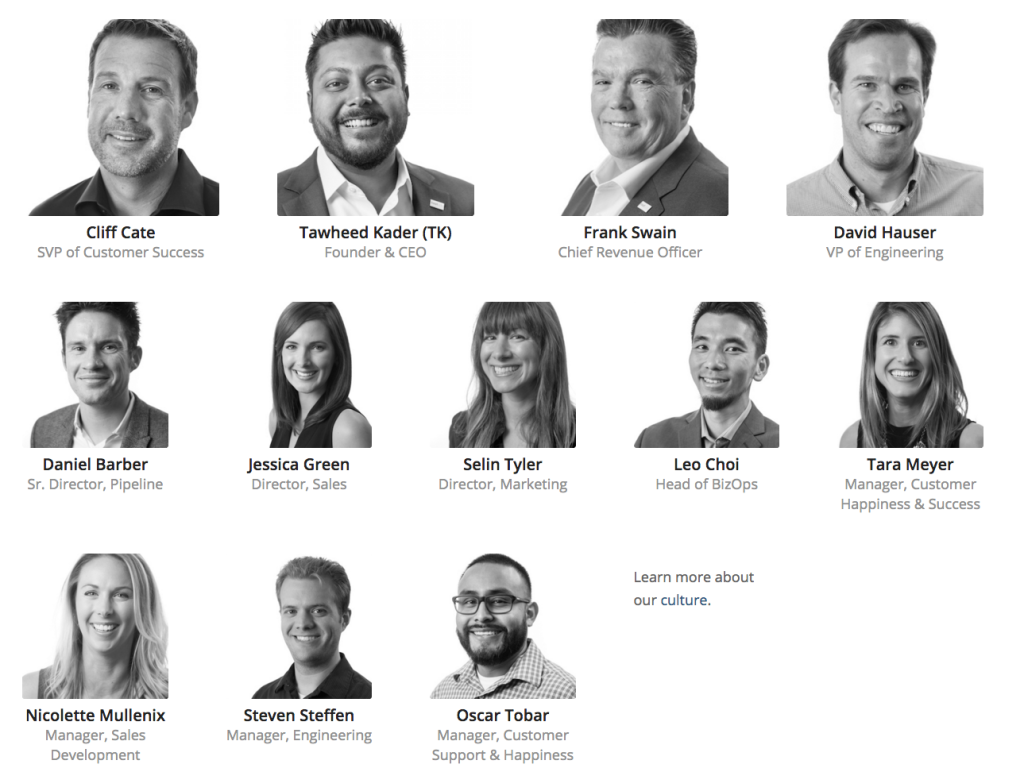
That’s the executive overview. The rest of this blog post highlights 4 key lessons I’ve learned as I grew to be the CEO of a 65-person+ company creating a brand new category of sales software.
Lesson #1 – Recruiting a stellar team is Job #1
It was sometime in Q3 of 2015. I was sitting at Bob’s Steak House (my favorite restaurant for recruiting dinners) and was having dinner with a VP candidate and his significant other (yes it was just the three of us).
We had done our reference checks, the team had done their interviews, this was the final step in our process, to get buy in from all remaining stakeholders.
How do you prep for a dinner with a VP you absolutely want on-board, no girlfriend to take as a date, and a significant other of the VP that happened to be a sales leader ”” which happened to be our prototypical customer?
Just like anything else in #ceolife ”” you dive right in.
Throughout 2014 and 2015, Perhaps my biggest allocation of time went toward being the Chief Recruiting Officer.
While I ended up serving in several quasi-leadership roles including VP Engineering, VP Marketing, and most importantly VP Sales ”” all while having to do the CEO – a huge amount of my time toward building a great leadership team.
Here’s the thing. Every CEO knows Recruiting (just like Fundraising) is an important aspect of the job. But not every CEO treats it like a business process and builds a machine around it.
The biggest win for us in 2014 & 2015 was our ability to build out the leadership team we have today.
The team today includes our CRO, VP of Engineering, SVP of Customer Success, Director of Marketing, Director of Sales, Director of Pipeline, and Head of BizOps.
The key lesson I learned was that had we not built a whole business process and machine around recruiting, we would not have been able to build the team that we have today in such a short amount of time (especially since 80% of this team was built over the first three quarters of 2015).
Going back to that dinner”¦ At the time of that dinner, I was working with three different executive recruiters on three separate executive searches.
One of the searches we had to re-start because the VP of Sales we hired quit after three weeks!
In a way, I loved running three at once because it forced me to think deeply about how to run effective recruiting processes ”” with one you can run it fast and loose, with two, you focus, with three, you have to run it like a job.
In running these Director and VP level searches, here are the key things I learned and employ for every search:
- Have a great search partner. I interviewed countless executive recruiters before picking one to do my search. In addition to that, I never “stuck with the firm.” Just because they were good at recruiting VPs of Sales, doesn’t mean they were good at VPs of Marketing. Hiring a great recruiting firm is absolutely worth the $85 to $100k you’ll spend on that hire.
- Standardize on how you track candidates – I made each of my executive recruiters use a standard Google Spreadsheet template that I created so that every search looked and felt the same. We tracked the same things, we used the same color coding, and most importantly, I had the status of each search right at my fingertips. It’s no secret that executive researches handle multiple searches at once and often use associates as leverage. My spreadsheet automatically highlighted if they were slacking ”” and they knew it before I had to tell them because they looked at the same thing I looked at. It held everyone accountable and kept everyone organized.
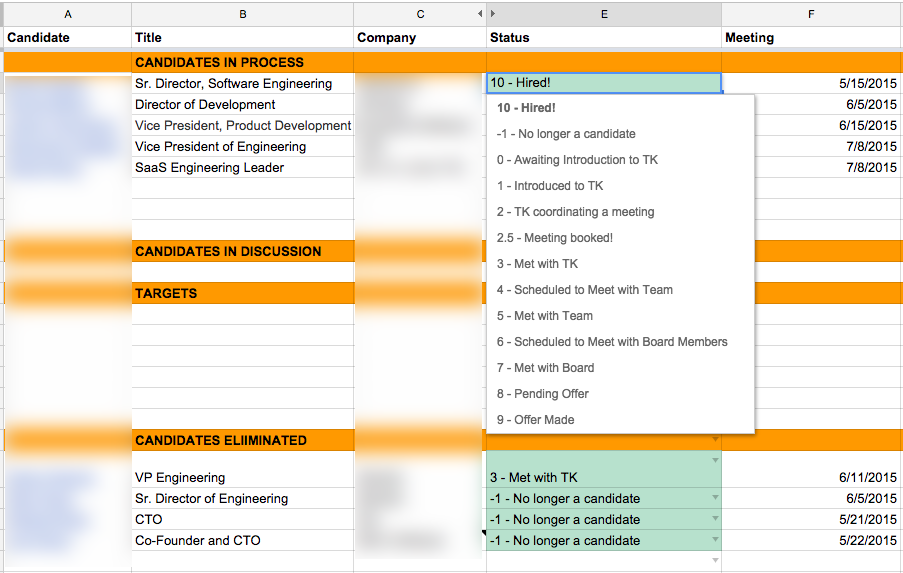 Standardize on where and how you interview – I used the same coffee shop (Starbucks on Broadway), the same dinner place (Bob’s Steak House), and the same place to close (a place they choose in their neighborhood on a Sunday). I kept the basics of the playbook the same and hyper-optimized. By the time 2015 ended, the waiters at Bob’s Steak House knew me. What that also meant was that as I ran through the process, I didn’t have to scramble to figure out stupid stuff ”” I was able to figure out what was important: vetting the candidate, and reaching a win-win scenario.
Standardize on where and how you interview – I used the same coffee shop (Starbucks on Broadway), the same dinner place (Bob’s Steak House), and the same place to close (a place they choose in their neighborhood on a Sunday). I kept the basics of the playbook the same and hyper-optimized. By the time 2015 ended, the waiters at Bob’s Steak House knew me. What that also meant was that as I ran through the process, I didn’t have to scramble to figure out stupid stuff ”” I was able to figure out what was important: vetting the candidate, and reaching a win-win scenario.- Don’t sell too hard – I hired a VP of Sales in the middle of 2015. Three weeks later he quit. He said his heart wasn’t in it. The truth was, we sold him too hard. We had investors email him, I ran an aggressive process, and even though I knew his heart was in a competing offer, I wanted to win. Quite honestly, between celebrity investors emailing him and welcoming him to the family, flowers delivered for Mother’s Day, and everything else we pulled, we made it very hard for him to say no ”” even though BOTH sides should have said NO and seen the early warning signs. I learned the lesson the hard way, but I learned this: you learn the most about a candidate in the last mile as you go to offer. So pay special attention, and listen to your gut.
- Realize you’re dealing with real lives – It’s really easy to get caught up in your own objectives to build teams, close deals, and take names. But for a moment, pause and realize that you’re dealing with real lives here. People have their own dreams, aspirations, familial obligations. If you’re serious about a candidate, get to know those things and make sure you’re creating win-win career opportunities for them. Otherwise, it won’t work in the long run.
Lesson #2 – You have to be ruthless about how you run your operations
We’ve always been purposeful about being a well run company. But it was sometime in early in 2015, Cliff and I were sitting in our 1on1, which was really part strategy sessions back then but really part therapy sessions for both of us.
I said “Man”¦ I feel like we have more people than ever, but we’re getting less stuff done.”
At that time, Cliff was running both Success and Support as we were ramping up the # of people in each, and I was serving as quasi VP-Sales along with everything else. I was also actively running a VP of Sales search.
One of the things I love about my entire leadership team today is that each of them has seen the movie before. Cliff nodded. He said, well – “We are coming up on the limits of how many people each manager can effectively manage.”
That conversation got me thinking. In order to crush your competitors, you need three things:
- A better product
- A stellar customer experience
- Be a better run company
Most CEOs focus on #1 or #2. Getting #3 right has always been a priority of mine, but we needed to get ruthless about it.
The truth is, you need to be damn great all three to be a successful company.
Through 2015, I’ve developed a set of practices across ToutApp to ensure we’re a better run company ”” I refer to it as Operational Ruthlessness and it is colloquially referred to as “Running it like a fucking job.”
I think this is something that happens in every company as you hit 30 to 40 employees, and unless you get ahead of it, you’re destined to fall apart. We implemented Operational Ruthlessness in three stages throughout 2015.
- Stage #1 – We took immediate steps to get leverage for managers by introducing the idea of Team Leads. We took high performers across the organization and offered to give them more responsibility for career growth. This got every manager immediate leverage, and showed employees career growth. Win win.
- Stage #2 – Whereas before I had only been focused on hiring VPs and Directors, we started to look at instituting true managers. Fortunately for us, there were already a set of independent individual contributors already in the company who were ready to step up as manager given the amount of prior work experience they had. So we prompted them. Boom, more career growth, more leverage, more happy employees.
- Stage #3 – With VPs, Directors, and now Managers and Team Leads, I started to worry and think deeply about getting all these people aligned around the right goals. And so this is where we really started to put together some core principles that I now refer to Operational Ruthlessness. It was a definition of how we’d run the company every week.
Key Components of Operational Ruthlessness:
- OKRs : We started with defining a set of objectives and key results we wanted for the company as a whole. Through a series of quarterly offsets first at the executive level, and then at the leadership level, we went into each quarter with clear definitions on what we wanted to achieve as a company.
- Metrics : Based on the OKRs, we all agreed on a set of core metrics each leader in the company would own and report on in a weekly basis. We hated knowing “after the fact” that something wasn’t working in a part of the business, and now with more managers, there was simply more things that could go wrong. So each leader got in sync on the core metrics (2 to 4 max) they’d track as a health of their area ”” and made a pledge to enter it into a standardized spreadsheet every Sunday night along with their top priorities, key blockers, and things they needed help with.
- Structured Cadence : With objectives, key results, and metrics to measure them with in place, I needed a forum in which we could all get in sync and essentially establish a “drumbeat” for the business. So, I set up a Monday morning leadership meeting, where everyone would come into it with already have read through our spreadsheet report which highlighted key metrics, problem areas, and red flags. In the meeting, at 9am on Monday, each leader would provide a “synthesis” of their business area. This is the point where magic ensued.
The thing with a SaaS business is that all these different areas are intertwined. The campaign that marketing runs affects the inbound leads that Sales relies on.
By having everyone report core metrics in one place, the meeting went toward collectively looking at patterns and talking about it.
In real-time, Marketing talked to Sales Development about inbound lead flow, and each made action items on whether the new campaigns that were running would require additional headcount on the inbound lead processing side.
I loved it. For me, it was a “Look ma! no hands” moment.
The structured meeting also turned into our early warning system.
As a leadership team, we got a sense of what was “on track” and wasn’t by week 2 of a month ”” we knew if we were ahead, behind, and that meant again, in real-time, we could forge strategies on changes we could make and partner on.
A ton of additional things go into the idea around Operational Ruthlessness, and I wrote a whole post about it here.
The key takeaway here is to think actively about how you run your business ”” efficiently ”” and better than your competition.
If you’re a better run business, with a better product, and a better customer experience, you will demolish your competitors in the long run, and I sleep very well at night knowing that.
Lesson #3 – Reboot your schedule every quarter
It was the first week of Q3 of 2015. And as I looked at my calendar Sunday night and scoped out what my week would look like, things felt off.
By this time, I knew exactly why it felt off. But Q2 of 2014 (over a year ago), the same sinking feeling hit my stomach and I couldn’t figure out why.
Here’s the thing to realize when you’re the CEO of a fast growth SaaS business. Every quarter, you’re managing a completely different business. Every quarter, you have a completely different job.
With new leaders coming on, with more employees, with different initiatives, it all changes, and it all changes at a very rapid clip.
I smiled, and said to myself: “I guess it’s that time again.”
I run my days, weeks, and months, through a series of weekly recurring standing meetings with key people across the company.
While that has stayed a constant, how much time I spend and with who is something I find I had to reevaluate every quarter.
While having recurring meetings, and re-evaluating how you run your business every quarter is obvious advice, here are some things to consider as you set up your calendar based on challenges you’re facing in the company.
- 1on1s: Separate out logistics from careers
As both a CEO and a manager, I tend to run a lot of 1on1s. One of the biggest rules we instituted in Tout for all managers is to ensure we separate meetings that are talking about logistics (how’s that project? where are you on that deliverable?) from 1on1s that are for career.By and large, we drive for weekly 1on1s for logistics and checkins, and monthly 1on1s for career/how’re you doing and essentially what I call “the meta.” - Know when to book 90-minute meetings
I’ve found that key business areas and leaders that you manage are either in Design stage or Execution stage.When you’re in Design stages, you’ll notice that the 45-minute meetings you have with that leader always sprawls into creating four additional 30 to 45 minute meetings to discuss various things.When you’re in Execution stage, you’ll notice that a weekly 45-minute check-in is just right to figure out how things are trending, give actionable advice, and keep things rocking.
Now, I hate meetings. But they’re necessary to get shit done. So, one of the things I always watch out for is the first case scenario when that 45-minute meeting just isn’t enough.
So over the past 3 quarters, when it came to working with leaders that were in Design phases, or were ramping, I scheduled weekly recurring 90 minute meetings with them.
Some of them balked at the idea of a 90-minute meeting, I snapped back “Look. You’re going to book additional meetings and take up way more of my time anyway, so let’s just get it all done with no context switching.”
So, book 90-minute meetings when you’re in design phases.
Ask for Agendas; Have a shared Google Doc
I don’t quite know when this started to happen, but I started doing scheduled meetings by saying “OK. It’s your time, what do you want to do?”
This was my way of communicating, I’ve allocated this time for you. It’s your job to make sure we get the most done so that you can achieve your OKRs.
It was magical.
People started showing up with an agenda, they even started to highlight the key things they wanted to accomplish, and god forbid someone called a meeting with me in it and didn’t have an answer ”” well let’s just say that didn’t happen a second time around.
The one additional thing I instituted as a step beyond the agenda was to have a shared Google document for that meeting.
We used it to write down agenda items, action items, and notes, so that in the next meeting, there was a complete stream of consciousness for us to refer back to.
Lesson #4 – Learn to context switch, compartmentalize, and prioritize
When I was raising angel funding for ToutApp back in 2011, the pitch went into “here’s what we’re doing for marketing”¦” and “here’s how we’re thinking about product roadmap”¦”
Investors would quickly and astutely interrupt me and say “Wait.. wait.. WE, you mean You.. It’s just you right?!”
I would snarkily comment back “It’s the royal WE”
The point is that back then, I had my hand in everything. I was Marketing, Product, Sales, Engineering, and even Support.
To get good at those things, I read countless books, blog posts, and took countless coffees to learn each of those crafts so that we could dominate in each of those areas.
Naturally, as we grew, we hired people to own each of those crafts, then we hired managers for each of those areas, and even leaders in each of those areas.
While today it is no longer the royal WE, and there are people smarter than me running each of those disciplines, the job of the CEO still requires that you understand all the different areas of the business, can can be called upon when tough decisions need to be made in terms of strategy and direction.
#1 – Learn to Context Switch
How does this manifest itself? Here’s three meetings I attended back to back on a typical day as CEO of ToutApp:
- a meeting with our top engineers walking me through our future architectural stack and the plan to migrate there without having to do a full rewrite
- a meeting with our marketing team talking about how to revamp our entire inbound lead generation strategy
- a recruiting meeting talking about headcount and how it impacts our budget.
The point is that you’re going to have to context switch rapidly between very detailed things, and you’re going to have to do it quickly, and be able to add value and make critical decisions that drastically impacts the business.
Part of this comes from just knowing your shit and studying it deeply. The other part of it comes from being cognizant that you will have to context switch, and allowing yourself 15-minutes in-between meetings to give your brain a chance to switch gears.
The 15-minutes was a piece of advice I received from Scott Weiss, our board member from a16z. It’s such a simple thing but has made a tremendous impact in my productivity.
#2 – Learn to Compartmentalize and Prioritize
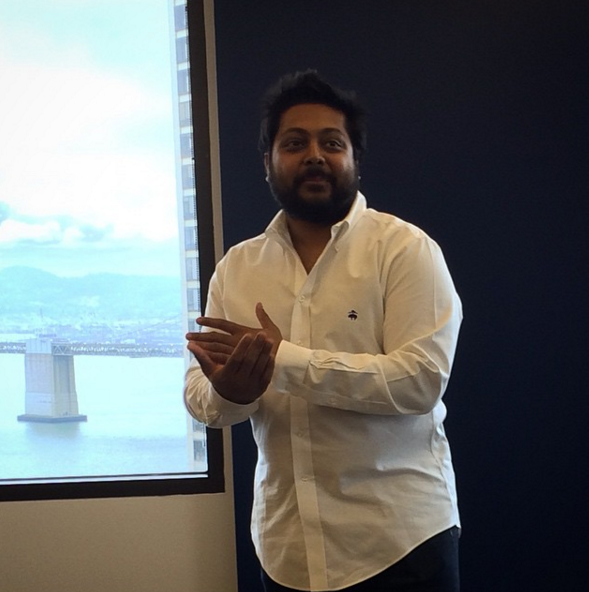
2015 also happened to be a year where I was going through a divorce. Above is a picture of me welcoming the company to our new offices and talking about how this new space is an investment in us and our customers.
This was the morning after I had to have some really tough calls with my divorce lawyers because the proceedings weren’t going very ”” err”” amicably.
This also happened to be a few days before our VP of Sales would quit after THREE weeks on the job.
How do you handle all these different fires? Compartmentalize the shit out of it.
I allowed for weekends to deal with personal things and would leave it at home when I went to the office.
And for every single unexpected problem or milestone in the business, you treat them separately, meditate, and learn to deal with the next most important thing instead of everything all at once.
If you’re able to compartmentalize and prioritize, you’ll eventually reach a zen-like attitude where you’re able to constantly deal with the most important or strategic thing at hand, solve it, and then move to the next thing.
That’s what I like to call CEO nirvana.
You do this long enough, you’ll get through all your problems and end with a stellar year. For comparison, above is a picture of me with my leadership team built, divorce done, and welcoming our company to our 2015 Holiday Party.
Make no mistake though, there’s still more shit to deal with. So while I’m enjoying, I’m really just saying to myself: OK, What am I missing? What’s going to blow up and I need to fix…
Special Thanks
The last two years of progress made at ToutApp, and my own growth as CEO would not be possible if it weren’t for each and every person involved with the company. However, there are some special mentions that are warranted:
- The entire leadership team, and all of our employees at ToutApp for joining us and their dedication to our mission & cause every day
- Scott Weiss and Greg Gretsch for being fantastic and supportive investors & board members
- Cliff Cate, Daniel Barber, and Jess Green, for being a bedrock in our leadership team since early 2014
- Eileen Wiens for helping us build our initial sales team back in 2014
- Jason Lemkin for writing what I call the bible of salvation for SaaS founders, particular his post about The Cavalry is Coming even though he totally dinged me on The Gift for not hiring his sales leader (sorry dude, he just wasn’t ready)
- Nick Mehta and Mark Organ, the 2nd-timer SaaS CEOs that are so giving to the community in terms of time and advice while running their own businesses
- Each and every one of our early investors including 500Startups, Founder Collective, Esther Dyson, Eric Ries, Jason Calacanis and others.
In Conclusion
In conclusion, 2014 and 2015 were what I’d call insane years in terms of my growth as a CEO.
ToutApp started nearly five years ago as a simple idea in my 2nd bedroom of my apartment in Connecticut.
I’m finishing up this blog post having come back from a short vacation, while sitting on the 29th floor of 1 California while blasting my favorite Shaggy song on the sound system in our reception area.
At the end of the day, I feel humbled and blessed every single day for even having the opportunity to be at the helm of this company.
As I look onward to 2016, and as I think about the triumphs and tribulations of 2015, I’m reminded of my favorite phrase of all time:
This too shall pass.
Meaning, for the good times, this too shall pass, and for the bad times, this too shall pass. So enjoy the now.
There will always be battles to fight, and celebrations to kick off; the biggest lesson I’ve learned as CEO is to remain stoic, and focus on the next hard thing.
Here’s to 2016. #weclosedeals.



